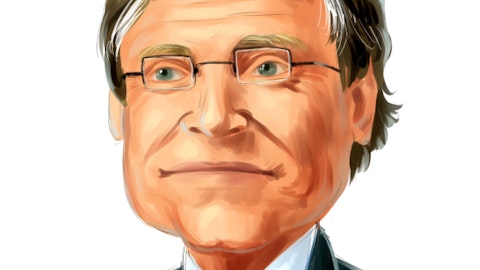FedEx Corporation (NYSE:FDX) Q2 2024 Earnings Call Transcript December 19, 2023
FedEx Corporation misses on earnings expectations. Reported EPS is $3.99 EPS, expectations were $4.18. FDX isn’t one of the 30 most popular stocks among hedge funds at the end of the third quarter (see the details here).
Operator: Good day, and welcome to the FedEx Fiscal Year 2024 Second Quarter Earnings Call. All participants are in a listen-only mode. [Operator Instructions] After today’s presentation, there will be an opportunity to ask questions. [Operator Instructions] Please note, this event is being recorded. I would now like to turn the conference over to Mr. Stephen Hughes, Director of Investor Relations. Please go ahead, sir.
Stephen Hughes: Good afternoon, and welcome to FedEx Corporation’s Second Quarter Earnings Conference Call. The second quarter earnings release, Form 10-Q, and Stat Book are on our website at investors.fedex.com. This call and the accompanying slides are being streamed from our website, where the replay and slides will be available for about one year. Joining us on the call today are members of the media. During our Q&A session, callers will be limited to one question in order to allow us to accommodate all those who would like to participate. Certain statements in this conference call, such as projections regarding future performance, may be considered forward-looking statements. Such forward-looking statements are subject to risks, uncertainties, and other factors which could cause actual results to differ materially from those expressed or implied by such forward-looking statements.
For additional information on these factors, please refer to our press releases and filings with the SEC. Please refer to the Investor Relations portion of our website at fedex.com for a reconciliation of the non-GAAP financial measures discussed on this call to the most directly comparable GAAP measures. Joining us on the call today are: Raj Subramaniam, President and CEO; Brie Carere, Executive Vice President, Chief Customer Officer; and John Dietrich, Executive Vice President and CFO. I’ll now turn it over to Raj, who will share his views on the quarter.
Raj Subramaniam: Thank you, Steve, and good afternoon, everyone. Let me begin by thanking the FedEx team for their commitment to delivering yet another strong holiday season. This peak, FedEx has the best service offerings in the industry. This includes the most expansive global network and the fastest US ground service with the broadest weekend residential coverage. Strong service and speed are also come in with a more aggressive peak transit compared to this time last year, with the ground time and transit in the US at 1.94 days. I’m incredibly proud of the team’s ability to sustain superior service levels while we continue to transform our global network. Our second quarter performance reflects clear signs of progress in our transformation in what remains a difficult demand environment.
We are moving with speed and agility to deliver on DRIVE, which is supporting improved profitability and enabling us to maintain our earnings outlook for the year, even as our revenue expectations have moderated further. As you can see in our results, in Slide 6, our transformation is driving improved profitability. At the enterprise level, we delivered a 17% improvement in adjusted operating income, and adjusted margin improvement of 110 basis points compared to the prior year even as the total revenue declined 3%. These results reflect benefits from DRIVE, a continued focus on revenue quality, and meaningful differentiation across our products and services as we build the world’s smartest logistics network. Our focused execution enabled us to retain a majority of the high-quality volume we won over the summer from UPS and as a result of the Yellow shutdown.
In the segment level, Ground continued to deliver outstanding results with adjusting operating income up 57%, and adjusted margin expansion of 370 basis points. This was driven in part by revenue growth due to higher yield and volume combined with solid operational performance. Freight delivered strong performance as well, driving double-digit profit improvement, and margin expansion of over 270 basis points compared to the prior year. Express total revenue declined due to both volume and yield pressures. These headwinds more than offset continued benefits from DRIVE and led to a margin decline compared to the prior year. There’s more work to do at Express, where we are structurally re-designing our network for speed and density. We continue to make progress at Express to unlock the value that exists across this business.
Turning to Slide 7. DRIVE continues to fundamentally change the way we work. The impact of DRIVE is clear, as our lower cost structure enables improved profitability. Just look at the powerful chart on the left-hand side of this slide. If you look across market cycles over the last 15 years, we have now delivered two consecutive quarters of operating income growth against declining revenues. When you step back and review how our business has performed in environments with suppressed demand, we are delivering much better profitability today than we have historically. In the quarter, we reduced costs by approximately $200 million in our Surface Network, including our US Express operations. This was driven by shifting to a single daily courier dispatch, applying dock productivity initiatives, consolidating underutilized sorts, and maximizing the use of rail.
Across our Air Network and International operations, our DRIVE initiatives are helping offset pressures with about $115 million in total cost reductions in Q2, primarily driven by structural flight takedowns. And in G&A, we’re making significant changes to how we approach procurement and functional excellence. In the second quarter, we realized over $100 million in savings driven by reducing the use of temporary labor, leveraging the scale of the Enterprise to negotiate favorable surface transportation rates, optimizing certain benefit programs, and lowering headcount. Given our progress, we are highly confident that we’ll deliver on our goal of $1.8 billion in cost reduction benefits from DRIVE this fiscal year. Turning to Slide 8. Despite progress on DRIVE, profitability at FedEx Express was pressured by an ongoing volume mix-shift and related yield headwinds.
Our ability to drive margin improvement in the near term has been constrained by transitory factors including the year-over-year decline in the US Postal Service volume, combined with minimum required service obligations associated with our current USPS contract. And also, the timing of the structural redesign of our Air Network. Historically, our unmatched global Air Network was primarily built on a hub-and-spoke system to support speed and global connectivity. With the rapid growth of e-commerce and as volume mix continues to shift to deferred, we recognize the need to reconfigure our network to focus on both speed and density. This fundamental network redesign, which we call Tricolor design, is momentus in our history, and includes several key elements.
First, we will deploy what we call our Purple Tail fleet, which is our FedEx-owned assets timed for delivering high-priority high-margin volumes using the existing hub-and-spoke model. This is our Purple Network, which will be the backbone of our International Priority parcel business. Second, we will re-time a portion of our Purple Tail flights for what we call our Orange Network which will operate off-cycle. This change will give us time to build density, decongest our hubs during the precious night short, and feed into our Surface Networks, including our International Road Network, as well as FedEx Ground and FedEx Freight in the US. This provides us a differentiated capability to drive profitable, less capital-intensive growth in the sizable global deferred parcel and airfreight markets.
And third, we will continue to leverage our Global Partner Network as an adaptive capacity layer, particularly on imbalanced trade lanes. This is our White Network. These changes will improve the utilization of our assets, increase margins, and enhance ROIC. The Air Network redesign is a critical piece of our DRIVE execution at Express and will support the realization of our targeted $4 billion of total DRIVE savings in fiscal year 2025. We are approaching this network transformation in a deliberately measured manner to ensure we continue to provide our customers with the best service levels in the industry. Simultaneously, as you know, we are executing Network 2.0. Taken together, these efforts will improve our ability to protect profitability and returns through various market environments.
Big picture, we are making clear progress on our transformation and DRIVE is having a real impact. Additionally, our team is advancing efforts to combine the strength of our physical transportation network with our digital and data-driven solutions. We are leveraging our world-class engineering skill base to deliver cost-effective cutting-edge capabilities globally. Earlier this month, we opened our first Advanced Capability Community or ACC in Hyderabad, India, which will serve as a hub for our technological and digital innovation. I’m truly excited about the opening of the ACC and the vast opportunity to use digital to run our business better, enhance our customer experience, and generate new profitable revenue streams. Overall, I’m confident we have the right strategy and the right team in place to create significant stockholder value.
In these last few months and weeks, our team’s dedication to the Purple Promise has been tremendous and I would like to express my sincere thanks to our colleagues. This performance has put FedEx in good position as we enter the final structural peak and deliver the best service offerings in the industry. With that, let me turn the call over to Brie.
Brie Carere: Thank you, Raj, and good afternoon, everyone. Revenue quality and industry-leading service remained top priorities for us in the quarter. Our ability to retain the majority of the business we won from both UPS and Yellow is a testament to the team’s hard work and our value proposition, which is the best service offering in the industry. And as a result, we are gaining parcel share here in the United States and around the world. Looking at the US, market conditions remained soft, with Q2 demand lower than we anticipated. The industry has now experienced 10 consecutive quarters of decline in US domestic average daily volume. Additionally, International market pressure continued. Despite this pressure, our Europe and EMEA teams did a great job of growing parcel volume.

Let’s now look at each segment. At FedEx Ground, second quarter revenue was up 3% year-over-year, driven by higher yield and volume. We remained focused on growing our business with the right customer and service mix to improve profitability and maintain our position as the price leader in every domestic market segment. At FedEx Freight, new customers that came over as a result of the Yellow shutdown, are enjoying a better value proposition, and we have retained a majority of this volume. Freight results showcase our disciplined focus on revenue quality as we gained share amid the industry disruptions. The market was down and revenue declined 4% as lower shipments offset an increase in yield. But on a sequential basis, our revenue decline moderated significantly as the volume pressure lessened and revenue per shipment impacted positively.
Revenue at FedEx Express was down 6% year-over-year, driven by market contraction and lower fuel and demand surcharges. Global freight pounds were down 18% year-over-year, driven by lower Postal Service volume as well as the weakness in industrial production. Despite these headwinds, we are encouraged by the progress in areas we can control. For example, the improvement in European service levels enabled profitable share gains. With less than one week to Christmas, our focus remains on delivering outstanding service. Our networks are running extremely well and we are receiving very positive customer feedback this peak. We are delivering this excellent service while creating new value for customers and driving customer acquisition. This holiday season, we estimate over 365 million packages will be delivered with a picture showing proof of delivery, PPOD as we call it.
It’s a great new feature that has helped us win new customers. PPOD and other digital tools such as estimated delivery time window and FedEx Delivery Manager, provide customers with peace of mind when it comes to holiday shipments. Overall, this year’s peak season has been relatively similar to last year and it’s in line with our expectations. But looking ahead, we’re ready to support our customers for post-holiday returns. Our robust returns portfolio is well-positioned to handle the returns that inevitably follow peak. Our portfolio includes both a pre-labeled and a no-label, no-box solution that creates convenient, seamless experiences for retailers and for consumers. Now, taking a step back to look at monthly volumes during the quarter.
Importantly, as I mentioned earlier, we gained parcel share in both the United States and in International markets. This is a clear indication of our winning value proposition in a contracting market. Volumes have continued to improve sequentially with Ground and International export volumes maintaining last quarter’s trend of growth on a year-over-year basis. Turning to Slide 14. Overall, the market is competitive but rational, and we are committed to delivering on our revenue quality strategy. During the quarter, yield trends improved slightly, but the dynamics were mixed across the segments. At FedEx Ground, yield increased 1% driven by Home Delivery and Commercial Ground, offset by Ground Economy. Higher weight per package and favorable customer segment mix, offset a lower fuel surcharge, relative to the prior year.
At FedEx Freight, revenue per shipment increased 1%, with base rates strong despite lower fuel surcharges and weights. At FedEx Express, yield was pressured due to lower fuel and demand surcharges. Shifts towards e-commerce and the reopening of our International Economy Service in EMEA also pressured yield. We continue to focus on our revenue quality strategy. Earlier this month, we raised US Express and Ground fuel surcharges by 1%, and international Express fuel surcharges by 1.5%. Looking ahead, we expect a high capture rate from our 5.9% general rate increase. We will reset our delivery area surcharges consistent with our usual practice. As we’ve shared previously, we are also resetting our approach to dimensional pricing for International shipments.
This is moving from a shipment to a per piece dimensional pricing, which is the global market practice. We are confident in our strategy and we are balancing both volume and yield growth. Moving now to Slide 15. Raj mentioned our focus on digital and efforts to identify new revenue streams. I am particularly excited about our new Tracking API that we will launch in early 2024. Our Tracking API is for both e-commerce shippers and platforms, providing them with best-in-class visibility for their customers, including a picture proof of delivery. This new for-a-fee offering is a significant enhancement for our retail customers as well as for those third-party e-commerce platforms that rely on our data as an integral part of their value proposition.
This is just one example of how we’re thinking about our digital capabilities to better serve our customers and generate profitable incremental revenue for FedEx. In closing, I want to thank our entire global team for how they are executing around the world to deliver an absolutely positively outstanding peak season. And with that, I’ll turn it over to John to discuss the financials.
John Dietrich: Thanks, Brie. I’ll start on Slide 17. Despite a revenue decline, the FedEx team delivered improved profitability with strong adjusted operating margin growth, driven by a continued focus on revenue quality and execution of the Company’s DRIVE initiatives. Taking a closer look at our segment performance in the quarter, starting with Ground, the team continues to deliver strong results. Adjusted operating income increased 57% due to yield improvement, cost reductions, and higher volumes. Cost per package declined 2% driven by lower line-haul expense, and improved first and last-mile productivity. At Freight, operating income increased 11% during the quarter, driven by higher yields and increased efficiency, partially offset by lower shipments.
The team continues to focus on improving profitability while navigating this lower demand environment. And at Express, profitability was pressured as impacts of softening demand on revenue were only partially offset by structural and volume-related cost improvements. Adjusted operating income at Express declined 49% during the quarter on a 6% decline in revenue. As Raj mentioned, we have more work to do at Express and I’m confident that the structural redesign of our network and other DRIVE initiatives once complete, will make us more resilient in future periods of demand weakness. Now turning to our fiscal year outlook. Based on our performance year-to-date and our current view of the rest of the year, we are reaffirming our outlook for adjusted EPS in the range of $17 to $18.50.
At this midpoint of the range, we’re now assuming a low single-digit percentage decline in revenue. This is lower than our previous assumption of flat revenue growth. The reaffirmation of our earnings outlook despite the weaker demand environment, reflects the continued benefits of our transformation. We’ll continue to closely monitor the global demand environment and other key factors, including inventory restocking, inflation, and e-commerce trends, which informs our view of overall expected performance. With regard to our third quarter expectations, as we’ve shared previously, we anticipate our typical seasonality, which implies a lighter quarter sequentially for earnings. We’re also facing a higher comp at Ground given our exceptionally strong operating income performance during the third quarter of last year.
At the enterprise level, we continue to expect year-over-year adjusted margin expansion in FY 2024. At the segment level, we continue to expect adjusted margin improvement in FY 2024 at Ground. We also continue to expect Freight margin to remain strong in FY 2024, but lower than FY 2023, given volume reductions and yield pressure. And we now anticipate a modest year-over-year adjusted margin contraction at Express. Turning to Slide 19, and consistent with previous quarters, we’re providing a bridge to share how we’re thinking about operating profit considerations embedded in our full year outlook. For illustrative purposes, we continue to use adjusted operating profit of $6.3 billion equivalent to the adjusted EPS midpoint of $17.75. As a reminder, and while our revenue performance will vary based on market trends, we are committed to delivering the $1.8 billion in structural cost savings from our DRIVE initiatives.
Importantly, while this bridge remains the same as what we showed you in the first quarter, the composition of the second bar showing revenue net of cost increases, has changed significantly. We now forecast materially lower revenue but expect to achieve the same net profit impact of $500 million at the midpoint, as we proactively manage volume-related expenses and revenue quality in this difficult demand environment. Now moving to Slide 20. We remain focused on maintaining a strong balance sheet, prudent capital allocation, improved return on invested capital, all while providing increased shareholder returns. Our liquidity position remains strong, ending the quarter with $6.7 billion in cash. Capital expenditures for the quarter were $1.3 billion, bringing year-to-date CapEx to $2.6 billion.
And we continue to expect to achieve our target of less than 6.5% CapEx-to-revenue for the year. As we’ve previously stated, our capital expenditures will decline as we continue to reduce capital intensity, by reducing facility and other capacity investment, and continue to plan for lower annual aircraft CapEx. We still anticipate aircraft-related CapEx to decline to approximately $1 billion in fiscal year 2026. Consistent with our capital return priority, we completed another $500 million accelerated share repurchase transaction in the quarter. This brings our total share repurchases for the first six months of the fiscal year to $1 billion and $2.5 billion over the last 18 months. Looking ahead, we expect to repurchase an additional $1 billion in common stock this fiscal year, while also paying our dividend in line with our previously stated capital return plan.
Before we turn to Q&A, I just wanted to comment, that now that I’m nearly five months into my new role as CFO, I’m even more excited about our strategy, relentless focus on execution, and the opportunity ahead to create long-term value for all our stakeholders. I want to thank all our team members for their continued efforts and focus on our common goals. With that, let’s open it up for questions.
See also 15 Best Drinks for Sore Throat and Cough and 15 Highest Quality Hot Dog Brands in the US.
Q&A Session
Follow Fedex Corp (NYSE:FDX)
Follow Fedex Corp (NYSE:FDX)
Operator: Thank you. We will now begin the question-and-answer session. [Operator Instructions] And the first question will come from Ken Hoexter with Bank of America. Please go ahead.
Ken Hoexter: Great. Good afternoon. So, I guess, John or Raj, maybe just sticking with Express to start. Margins were down year-on-year. I get volumes were down and you have negative leverage. But just to be at 1.7%, we’re seeing higher purchase trends, higher employee expense. I guess, what does it really take, maybe just walk us through, one, why margins are stubbornly so low. And then, two, you’re talking about a new plan in terms of the Orange, Purple, and White plan. Are we talking about structurally changing Express in pulling additional costs out, parking more planes, pulling employees out? What does it take to get the structural margin out of this low bar? And I get you’re still in the middle of your range, so I get the earnings outlook. I’m just trying to understand just the constraint on Express and the ability to get the margins up there over time.
Raj Subramaniam: Yes. Thank you, Ken. Let me start and then John can add as he wishes here then. So, this has been a particularly difficult year for Express. Several headwinds this year, and many of them are transitory, but we’re dealing with this as we speak. So, firstly, the demand surcharges out of Asia are significantly lower year-over-year. We’ve also seen the product mix-shift from — shift from priority to economy traffic. And then, our fuel surcharges also have been lower. Finally, as part of the strategy from USPS, they have shifted more volume from air to ground, and so that’s been also a headwind for FedEx this year. On top of all this, we have seen now the market demand weaken primarily because of slowdown of industrial production across the world, which has impacted our International Express Freight business as well.
So, this is the background we are dealing with. I would say, that despite this, the team has done a really good job on execution on DRIVE, and flexing down variable cost to the tune of $1.5 billion in year-over-year expense reduction year-to-date. Clearly, Express is an opportunity for us as we look ahead. The redesign that I just talked about is very profound and what we call Tricolor, because recognizing the fact that we now have a significant mixture of Freight traffic, as well as deferred traffic, to change a portion of the existing flight schedule to a different clock, so to speak, allowing ability to drive more, ability to fill up the traffic and improve density, and again, most importantly, allowing us to feed into not only our International Road Network, but also into our FedEx Ground and FedEx Freight Network for the first time.
And so this is a significant change, probably one of the biggest changes we’ve seen in decades. I think that’s got the opportunity here to improve our asset utilization, improve density, improve return on invested capital in a significant manner. So, I just want to also just use this opportunity to say, at the enterprise level, we are — we have improved our operating profit 17% and 110 basis points in operating margins despite a 3% revenue decline. Let me turn it over to John to see if what he wants to add.
John Dietrich: Yes. Thanks, Raj. I echo everything you said. I think the only thing I would add is that, our cost structure, Ken, anticipated a little higher demand than what we saw, so we will be laser-focused on bringing out as much of that cost as possible as we go forward.
Operator: The next question will come from Chris Wetherbee with Citigroup. Please go ahead.
Chris Wetherbee: Hey, thanks, good afternoon. Maybe sticking on the back of that answer, John. I guess as you think about the sequential performance in Express from 1Q to 2Q, I don’t think we’ve seen nearly since maybe fiscal 2011, a deterioration in operating profit, revenue was up sequentially, so I guess, was it just a mix that was moving around, or maybe miss judging what you thought the demand environment was going to look like? And then, as we think about the back half of the year in Express, you’re facing particularly easier comps, both on a revenue and a profit basis, so I know margin is down for the full year, but can you can get margin and profit up in the back half of the fiscal year in Express?
John Dietrich: So, as you pointed out, there’s a whole host of factors that went into the Express performance, and as Raj mentioned, we see that there will be continuing opportunities at Express. The cost in terms of the relationship with the demand will definitely be a primary focus of mine, and as we go forward, I know Brie and the team are really focused on revenue quality. And we’re confident we’re going to be able to manage that outcome and look forward to keeping you posted as we go forward.
Operator: The next question will come from Helane Becker with TD Cowen. Please go ahead.
Helane Becker: Thanks very much, operator. Hi, everybody. I appreciate the time. One of the things that you talked about more on the last call than you did on this, although Brie, you did mention that you saw a shift in Postal Service business to Ground from Air, and I know the contract is up in at the end of the current government fiscal year. So, how are you thinking about incorporating the rest of the business into the network versus renewing the contract or maybe it doesn’t make sense to renew the contract going forward?
Brie Carere: Good afternoon. Great question. So, from a USPS perspective, yes, this was a significant headwind this quarter as it was last quarter. From a negotiation perspective, we are having very collaborative negotiations with the Post Office, but I think we’ve also been very clear that it will take quite a significant change in contractual terms and agreement to renew that contract. We continue to value the partnership. We’re both at the table. And of course, we are honoring our service commitments. And with the current volume levels, that is a headwind this fiscal year. So, we’re still negotiating. As soon as we have a renewed contract or a decision, we’ll let all of you know. I am optimistic one way or the other we will improve the profit situation at Express regardless of our relationship with the Post Office.
Operator: The next question will come from Scott Group with Wolfe Research. Please go ahead.
Scott Group: Hey, thanks. So, if I look, Ground yields were up about 1% in the quarter. Ground volumes in November now are flat. So going forward, is this still an environment where Ground margins should be improving year-over-year? I get the comps are harder, so less improvement, but you think you still see improvement in the back half of the year in Ground margin improvement? And then John, you talked about just seasonality lower in Q3. Maybe just some directional color on how much lower, and then what that means for Q4 and all that. Thank you.





